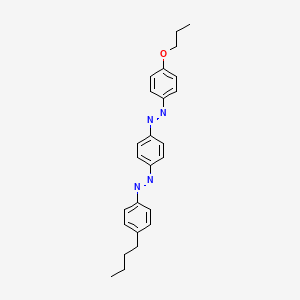

1. Wf8nwa83re
2. G 207
3. G 207 [who-dd]
4. G207
5. G-207
6. 80156-87-2
7. 2136340-90-2
8. 162320-00-5
9. Unii-wf8nwa83re
10. Schembl12425118
11. Schembl24849964
12. Dtxsid70612659
13. Zugkfnycfbdwio-uhfffaoysa-n
14. (e)-1-(4-butylphenyl)-2-{4-[(e)-(4-propoxyphenyl)diazenyl]phenyl}diazene
| Molecular Weight | 400.5 g/mol |
|---|---|
| Molecular Formula | C25H28N4O |
| XLogP3 | 8.2 |
| Hydrogen Bond Donor Count | 0 |
| Hydrogen Bond Acceptor Count | 5 |
| Rotatable Bond Count | 10 |
| Exact Mass | Da |
| Monoisotopic Mass | Da |
| Topological Polar Surface Area | 58.7 |
| Heavy Atom Count | 30 |
| Formal Charge | 0 |
| Complexity | 499 |
| Isotope Atom Count | 0 |
| Defined Atom Stereocenter Count | 0 |
| Undefined Atom Stereocenter Count | 0 |
| Defined Bond Stereocenter Count | 0 |
| Undefined Bond Stereocenter Count | 0 |
| Covalently Bonded Unit Count | 1 |
Investigated for use/treatment in brain cancer.
G207, Cancer killing viruses are modified to make them utilizable as a therapeutic agent in human by switching off certain genes that normally enable the virus to multiply in healthy cells, which would destroy these cells. As a result of this genetic modification, the HSVs are able to reproduce in tumor cells solely, since only this offer an environment that compensates for the loss of the removed viral genes. Consequently, the virus is able to replicate in the tumor cells, selectively destroying them without harming healthy tissue.

Contact Us!